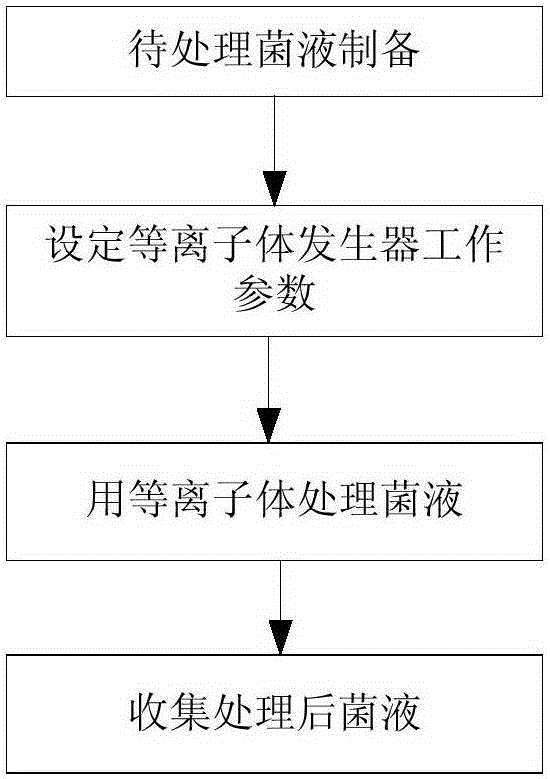A method for preparing microbial competent cells using atmospheric pressure room temperature plasma
A technology of competent cells and plasma, applied in the fields of biochemical equipment and methods, treatment of microorganisms and microorganisms with electricity/wave energy, etc.
- Summary
- Abstract
- Description
- Claims
- Application Information
AI Technical Summary
Problems solved by technology
Method used
Image
Examples
Embodiment 1
[0036] Example 1: Preparation of Escherichia coli Top10 strain competent cells and determination of transformation efficiency
[0037] 1. Materials and reagents
[0038] Material: recipient strain E.coliTOP10; plasmid: pUC
[0039] Reagents: LB liquid medium: peptone 10g, yeast extract 5g, NaCl 10g, distilled water to volume 1L, pH 7.0, sterilized at 121°C for 20min.
[0040] LB solid medium: agar 10g, peptone 10g, yeast extract 5g, NaCl 10g, distilled water to volume 1L, pH 7.0, sterilized at 121°C for 20min.
[0041] 2. Experimental equipment
[0042] ARTP (Atmospheric Room Temperature Plasma) Mutation Breeding System
[0043] 3. Experimental steps:
[0044] 1) Preparation of treatment solution: Pick a single colony from a solid plate growing Top10 strains and inoculate it in 5 mL of LB liquid medium, and incubate at 37°C for 12 to 16 hours; take 2 mL of the culture and inoculate it (5% inoculum) into 200 mL Continue to grow to OD in fresh LB liquid medium 600 0.5; t...
Embodiment 2
[0051] Example 2: Preparation of Escherichia coli DH5α Competent Cells and Measurement of Transformation Efficiency
[0052] 1. Materials and reagents
[0053] Materials: Recipient bacteria E.coliDH5α; plasmid pUC
[0054] Reagents: LB liquid medium: peptone 10g, yeast extract 5g, NaCl 10g, distilled water to volume 1L, pH 7.0, sterilized at 121°C for 20min.
[0055] LB solid medium: agar 10g, peptone 10g, yeast extract 5g, NaCl 10g, distilled water to volume 1L, pH 7.0, sterilized at 121°C for 20min.
[0056] 2. Experimental equipment
[0057] ARTP (Atmospheric Room Temperature Plasma) Mutation Breeding System
[0058] 3. Experimental steps
[0059] 1) Preparation of treatment solution: Pick a single colony on a solid plate growing DH5α strain and inoculate it in 5 mL of LB liquid medium, and incubate at 37°C for 12 to 16 hours; transfer 2 mL of the culture to inoculate (10% inoculum) into 200 mL Continue to grow to OD in fresh LB liquid medium 600 0.6; divide the bac...
Embodiment 3
[0066] Example 3: Preparation of Escherichia coli Top10 strain competent cells and determination of transformation efficiency
[0067] 1. Materials and reagents
[0068] Material: recipient strain E.coliTOP10; plasmid: pUC
[0069] Reagents: LB liquid medium: peptone 10g, yeast extract 5g, NaCl 10g, distilled water to volume 1L, pH 7.0, sterilized at 121°C for 20min.
[0070] LB solid medium: agar 10g, peptone 10g, yeast extract 5g, NaCl 10g, distilled water to volume 1L, pH 7.0, sterilized at 121°C for 20min.
[0071] 2. Experimental equipment
[0072] ARTP (Atmospheric Room Temperature Plasma) Mutation Breeding System
[0073] 4. Experimental steps:
[0074] 1) Preparation of treatment solution: Pick a single colony from a solid plate growing Top10 strains and inoculate it in 5 mL of LB liquid medium, and incubate at 37°C for 12 to 16 hours; take 2 mL of the culture and inoculate it (15% inoculum) into 200 mL Continue to grow to OD in fresh LB liquid medium 600 0.5 t...
PUM
 Login to View More
Login to View More Abstract
Description
Claims
Application Information
 Login to View More
Login to View More - R&D
- Intellectual Property
- Life Sciences
- Materials
- Tech Scout
- Unparalleled Data Quality
- Higher Quality Content
- 60% Fewer Hallucinations
Browse by: Latest US Patents, China's latest patents, Technical Efficacy Thesaurus, Application Domain, Technology Topic, Popular Technical Reports.
© 2025 PatSnap. All rights reserved.Legal|Privacy policy|Modern Slavery Act Transparency Statement|Sitemap|About US| Contact US: help@patsnap.com

